My Racing isn't feeling very well.
Can you help? Please! |
| |
|
Any owner having a problem with their Maserati can send me details and I will publish these, together
with any subsequent advice I receive, on this page.
Just drop me a line at maserati123@btopenworld.com |
| |
Even if I don't succeed in helping you with your problems; and I do try, it would help other Maserati owners a great deal if you could let me know how you managed to solve your problems. THANK YOU! |
| |
| |
 |
| |
| |
Cornis in The Netherlands writes: |
| |
"Hello Enrico,
I enjoy reviewing your site very much.
I have a problem that only occurs when I am on holiday abroad where the outer temperature is very hot (over 28°C) compared to the moderate temperatures in Holland.
I am the owner of a 1991 Racing and enjoy it very much. It has had an engine rebuild in Italy at Autofficina Europa two years ago. Last year when on holiday in Italy the problem started. When arriving at a junction driving downhill when you need to keep your foot on the brake until you are at a complete standstill, then the engine dies. When you try to start it again immediately, it will start without hesitation.
During my holiday the engine was started that often that the start motor failed and had to be replaced. I also had the stationair air valve replaced because I thought that that would cause the problem. Last weekend when driving to the Nürburgring in Germany for the classic car event, the problem was alive again as ever. The engine when running gives absolute perfect performance, if you keep the revs away from the idle position by using the side of your right foot then after a few seconds the motor picks up nice its idle revs and runs idle without any problems, with or without air-con, radio or other accessories on.
Some Maserati specialists that I consulted give very different suggestions, and I never succeed in reproducing the problem in front of their garage, but in the meantime my wife refuses to travel with me in the car to hot destinations because she is afraid the starter motor will fail again in the middle of a motorway.
I hope you can give some advice.
Cornis." |
| |
 |
| |
Quick reply from Enrico: |
| |
Re: Racing problem:
"Hi Cornis,
It occurs to me that most owners would like to know the cause of thios problem rather that the cure. What a great way to keep the wife at home!
No but seriously, I have forwarded your e-mail to Andy and await his reply with interest.
Enrico." |
| |
 |
| |
Reply from Rene: |
| |
Re: Racing problem:
"Hi Enrico,
Well, I suspect over flooding or starvation would be the problem, but I need to know a little more than the information given:
What is the actual temperature on the gauge when this problem occurs?
Are the fan’s blowing when this problem occurs.
Do you or did you smell fuel when this problem occurs?
What is the average mileage on your car?
Was it a total engine rebuild?
Did you perform a cylinder leak test and a scope computer test after the rebuilt? And if so, what is the read out?
While the engine is running, what is the ohm resistance between:
Body and engine?
The body and negative terminal battery?
The negative terminal battery and engine?
The engine and alternator?
the ignition coils and body?
If I can get answers to these questions I will get a better few on the engine.
Take care.
Rene." |
| |
| |
 |
| |
| |
Frédéric in France writes: |
| |
"The local Maserati dealer seems to have a lot of difficulty to locate the piston rings for my Racing.
Do you know if they are the same as on a Ghibli II?
Thank you.
Cheers,
Frédéric." |
| |
 |
| |
Reply from Enrico: |
| |
Re: Racing piston rings:
"Hi Frédéric,
Attached are three pages from the V6 engine parts manual for 18-valve and 24-valve engines.
24v-index.jpg shows the models whose engines are listed. Note number 490 is for the Racing and number 495 is for the Ghibli.
24v-pistons.jpg and 24v-pistonsa.jpg give you the required parts numbers.
You will notice that the pison rings for a Racing and a Ghibli II are the same.
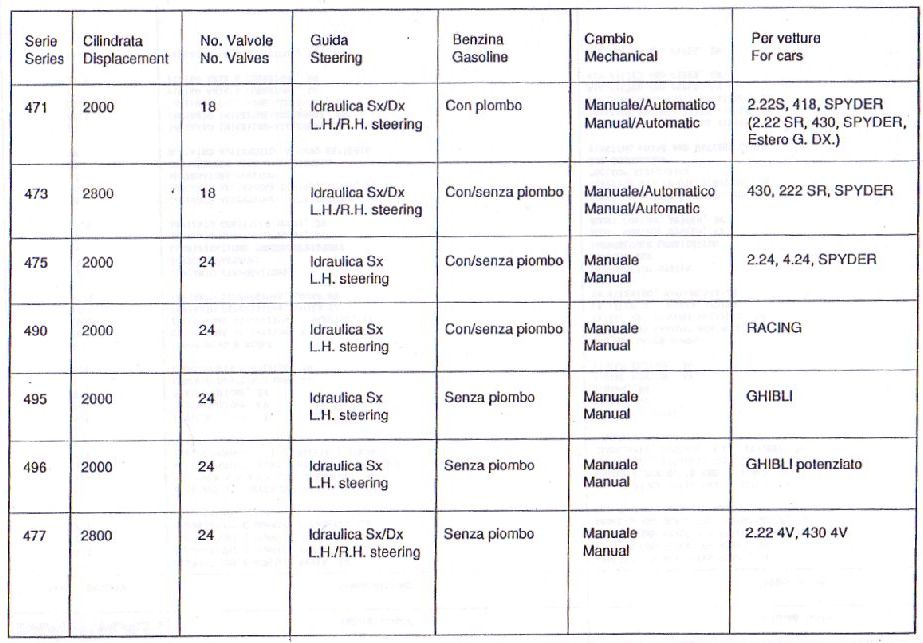
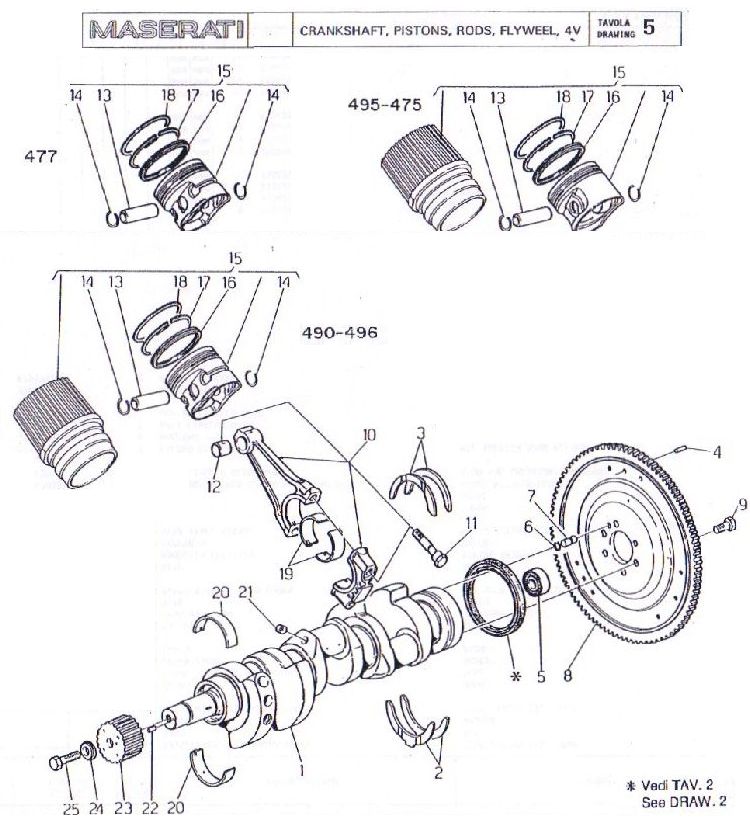
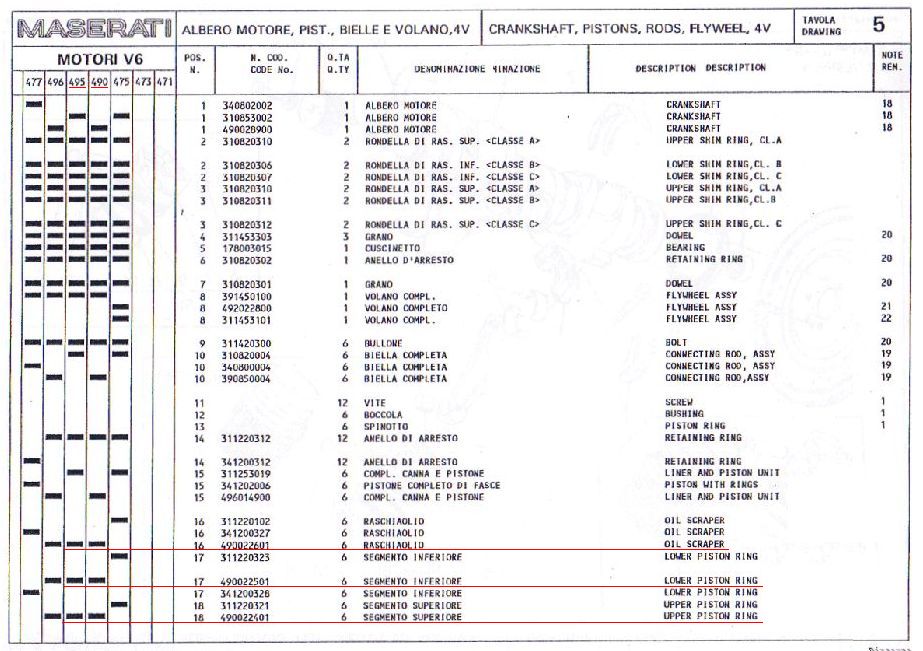
The information in the above parts manual relates to parts numbers for the series one Ghibli.
No 18 - Part number 490022401 (upper piston ring) has been superceded by part number 571022400.
No 17 - Part number 490022601 (oil scrapper) has been superceded by part number 571022600.
No 16 - Part number 490022501 (lower piston ring) remains the same.
Regards,
Enrico." |
| |
| |
 |
| |
| |
Frédéric in France writes: |
| |
"Enrico,
I own a 1991 Maserati Racing since January 2003. Last month the cambelt broke on me only 17000 km since it was last changed (about 5 years ago). A few valves have been bent after making contact with the pistons. I am trying to find replacement valves:
a) from the original valve manufacturer or
b) from a spare 4.24V engine that I will have access to, in a few days.
But looking at my Racing valves and at the literature available to me, I am a little bit confused.
Racing engine valves (measuring instrument tolerance +/- 0, 25mm, I guess)
Exhaust: 27.5mm dia, 7 mm stem, 110.5 mm length (should be sodium filled)
Intake: 30mm dia, 7 mm stem, 108.8 mm length
2.24v engine from literature (repair shop manual)
Exhaust: 26.1mm dia, 7 mm stem, ?? mm length
Intake: 29mm dia, 7 mm stem, ?? mm length
Can you confirm dimensions?
Can I use 2.24v valves?
Are the Racing valves the same as Ghibli II's?
Why such differences?
Thank you !
Frédéric." |
| |
 |
| |
Reply from Enrico: |
| |
Re: Racing valves:
"Hi Frédéric,
According to my V-6 24-valve engine parts manual, the valves for the 2.24v, the Racing and the 2.0-litre Ghibli are idnetical.
The part number for the intake valve for all three models is shown as 310653451 and the part number for the exhaust valve for all three models is showing 477032000.
If you order new valves from the factory, the part numbres shown have been superceded by another replacement valve that requires some extra parts to install as they are of a slightly different design.
I am told that Candini at info@candinimodena.net still has some of the earlier direct replacement valves in stock.
Enrico" |
| |
| |
 |
| |
| |
Frank in The Netherlands writes: |
| |
"Andy,
A few weeks ago I asked you a question on my '92 racing which has misfire problems. On your website you answered that this was probably caused by rotor or engine-earth problems. In the meantime we have looked at the problem and I thought I'd send you an update:
I have discovered how to generate the cut-out/misfires. With a warm engine, and above 3000 rpm, I can make the engine misfire by easing off the throttle to maintain a steady rpm, and then, just by pressing the pedal a little bit further down. The engine will react immediately by cutting-out and misfiring. We have checked crankshaft and camshaft sensors's signals. All OK. It turns out that the incoming signals are OK, but the misfire is caused by temporary lack of signal to the ignition coils.
We figure something is going wrong inside the ignition module. I've changed my module with the box from a 2.24v, keeping the Racing's Eprom. This ran fine for about 15 minutes, but then started to have similar symptoms. The engine also seemed to be running rough at higher revs. Since there is a slight difference between the Racing module (Med 602-R) and the 2.24V module (MED 602-C), I switched my Eprom back to the old Racing module.
Unless we are missing something, I can only conclude that the Eprom itself is causing the problem. Is this a know problem? Do you know where I can get the data for the Racing Eprom, so I can have it reprogrammed?
Thanks,
Frank." |
| |
 |
| |
Reply from Rossano of Repartocorse: |
| |
Re: Racing:
"Per ora ti invio gli schemi dove verificare l'impianto elettrico.
For now I am sending you two electrical diagrams and some instructions on the care of the electrical terminals to ensure good contact.
Il problema è sicuramente elettrico e può essere dato da varie cause per cui controllare:
The problem is almost certainly an electrical one and could be caused by many things, for this reason you should check:
* Stato delle candele.
* The condition of the spark plugs.
* Collegamento dei cavi candele, spesso non sono ben collegate e danno questo tipo di problema.
* The ignition leads, they can produce this type of fault if the connections aren't good.
* Stato delle bobine, potrebbe essere che con lo scaldarsi l'isolante lasci scaricare la corrente.
* The condition of the ignition coils, it could be that when they heat up, their insulation is allowing current to escape.
*Cavo di massa batteria/telaio.
*The earth/ negative (-) wire and its connections at the battery and the body.
*Cavi di massa alla centralina
* The negative (-) wires from the Marelli ignition control units.
* Relè vari in particolare quello che comanda la pompa benzina.
* The various relays, in particular the fuel pump relay.
Comunque un meccanico o meglio elettrauto con a disposizione un macchinario compiuterizzato tipo BEAR .. può facilmente ed in pochi minuti verificare da dove proviene il guasto.
* However a good mechanic or better still an automotive electrical engineer who has something like BEAR computerised diagnostic equipment at his disposal .. he should be able to trace the fault in a couple of minutes.
Rossano." |
| |
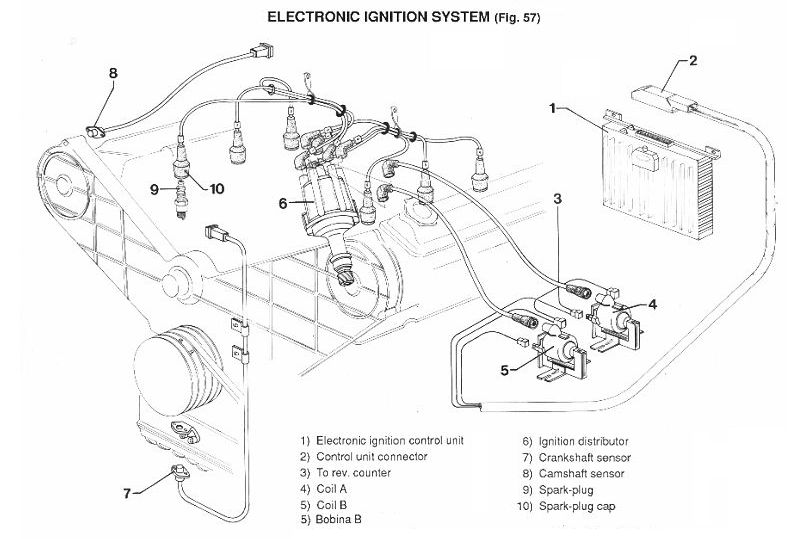 |
| |
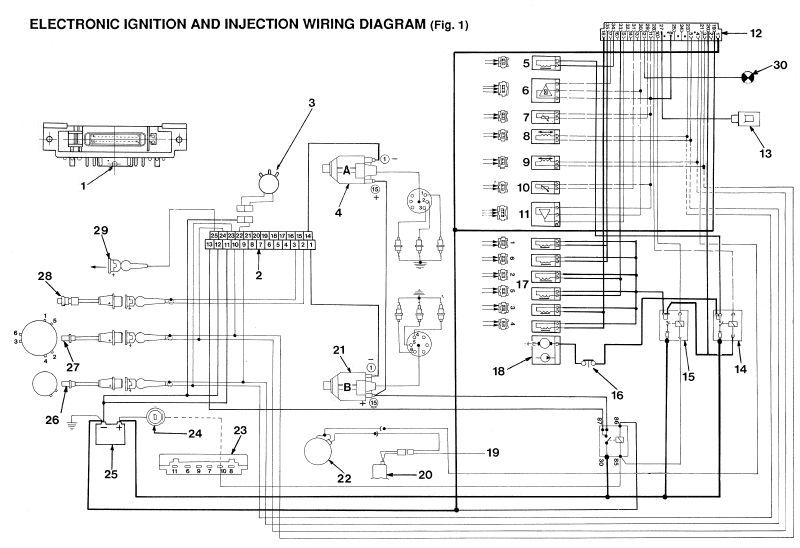 |
| |
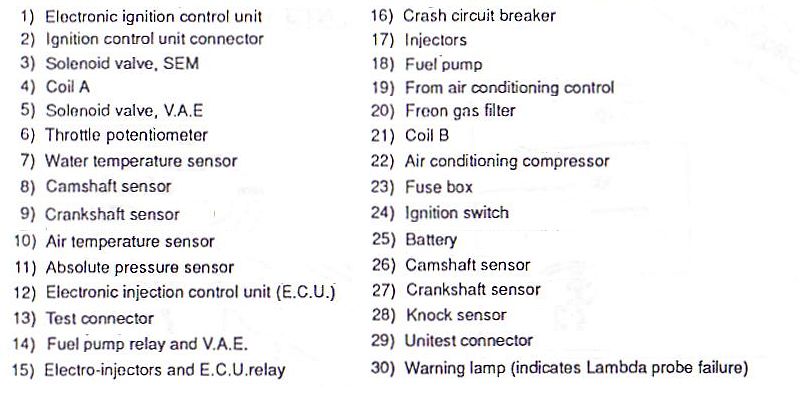 |
| |
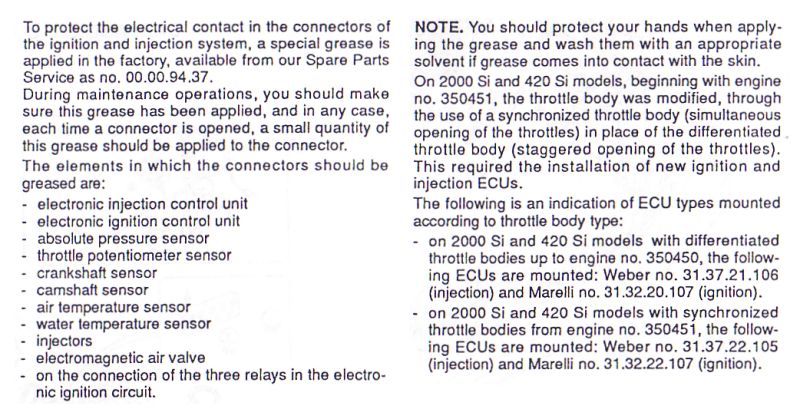 |
| |
| |
 |
| |
| |
Frank in The Netherlands writes: |
| |
"Hi,
Whilst looking for help on the misfiring problem with my '92 Racing, I noticed that there is someone else who had the same problems with his fuel gauge is my car is having.
Durran wrote:
"Actually the gauge flickers violently and continually, I suspect bad contacts somewhere in the circuitry, before I start stripping the thing down can anyone tell me if there is a common failing in the sender / gauge assemblies that causes this?"
My thoughts exactly! Maybe he has been able to identify the problem. I would appreciate any help on this.
Anyway. Now for my real problem:
A few weeks ago, my car stopped suddenly, and would not start again. I fiddled with the fuel pump relay, since I have had problems with this before. A few days later, the car started to stall more often. I found out that just waiting and then restarting was the only thing that helped (so it wasn't the fuel pump). Stalling only happened when the engine was warm. After a few days it got so bad that the car would not rev above 4000 rpm, even when cold, backfiring and cutting out when reaching that RPM. Measuring fuel pressure and low current signal at the ignition coil proved the ignition to be the problem. I replaced the crankshaft sensor and the engine ran fine again (or so I thought). Every now and again, the engine just cuts-out for a fraction of a second, sometimes resulting in a nice misfire. It sometimes doesn't happen for 10 miles, and than 3 times in one minute. Engine temperature and load, or weather don’t seem to be of influence.
Any help would be very much appreciated!
Thanks,
Frank." |
| |
 |
| |
Reply from Andy:- |
| |
Re: Racing:
"This running problem sounds like the usual of either a bad earth between the engine and the body or rotor arm. Fuel gauge strange - not normally a problem.
Andy." |
| |
| |
 |
| |
| |
Frederic in France writes: |
| |
"Hello,
I own a 1991 Racing model. I have seen several posts stating that the chains driving the second camshaft of each bank should be changed between 80 and 100,000 km. I do not see any reference of this maintenance activity in the manual.
What is your opinion?
This requires to take the engine off the car, isn't it?
Frederic." |
| |
 |
| |
Reply from Enrico:- |
| |
Re: Racing:
"Ciao Frederic,
The reason that there is no specific schedule for the changing of the two timing chains (situated at the rear of the camshafts in the cylinder heads) in the driver's manual is that there isn't one. Every driver treats his or her car differently, some drive with reasonable care others simply thrash their cars. For this reason, the timing chains would require changing at different intervals.
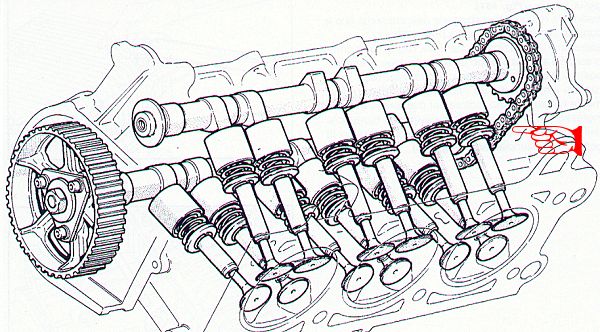
24-valve cylinder head showing the timing chain
The timing chains only require changing when the become noisy and this becomes increasingly obvious nearer the time.
Official Maserati workshops normally remove the engine to carry out this work. I have heard of some non-official Maserati workshops that are able to carry out this procedure without removing the engine but these are mechanics who know exactly what they are doing and this work should not be carried out by a mechanic without such experience.
Hope this helps,
Enrico." |







